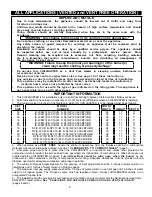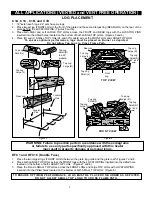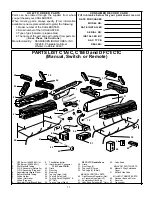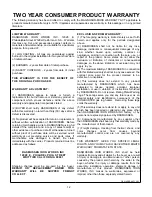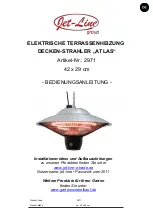
VENT FREE OPERATION
PROVISIONS FOR ADEQUATE COMBUSTION AND VENTILATION AIR
This heater shall not be installed in a "confined" space or unusually tight construction unless provisions
are provided for adequate combustion and ventilation air.
Confined Or Unconfined Space Determination:
The National Fuel Gas Code defines a confined space as a space whose volume is less than 50 cubic feet per 1,000
Btu per hour (4.8m
3
per kW) of the aggregate input rating of all appliances installed in that space and an unconfined
space as a space whose volume is not less than 50 cubic feet per 1,000 Btu per hour (4.8m
3
per kW) of the aggregate
input rating of all appliances installed in that space. Rooms communicating directly with the space in which the
appliances are installed, through openings not furnished with doors, are considered a part of the unconfined space.
Calculations To Determine Confined Or Unconfined Space:
1. Determine number of rooms (including adjoining rooms with doorless passageways or ventilation grates.)
Example:
Living room/dining room + Kitchen
2. Determine the Total Volume of the Space (width x length x height).
Example:
Living room/dining room
14' x 20' x 8' = 2240 cu ft
Kitchen
8' x 12' x 8' = 768 cu ft
Total Volume of Space
3008 cu ft
3. Divide the total space volume by 50 cuft to determine the Maximum Supportable Btu/Hr.
Example:
3008 cu ft ÷ 50 = 60.160 x 1000 =
6 0 , 1 6 0
Maximum Supportable Btu/Hr = 60,160 Btu/Hr
.
4. Add the rated (Btu/hr) of all fuel burning appliances in the "space" to determine Actual Btu/Hr Used.
Example:
Vent free gas log heater
40,000 Btu/Hr
Gas water heater
32,000 Btu/Hr
Actual Btu/Hr Used
7 2 , 0 0 0 B t u / H r
Note: Do not include direct vent gas appliances.
5. Compare Maximum Supportable Btu/Hr against Actual Btu/hr Used.
•If Actual Btu/Hr Used is greater than Maximum Supportable Btu/Hr then space is CONFINED.
•If the Actual Btu/Hr Used is less than Maximum Supportable Btu/Hr then space is UNCONFINED.
60,160 Btu/Hr = Maximum Supportable Btu/Hr
- 72,000 Btu/Hr = Actual Btu/Hr Used
- 11,840 Btu/Hr = Excess Non-Supportable Btu/Hr
In the example, because the Actual Btu/Hr Used exceeds the Maximum Supportable Btu/hr the space would
be considered a Confined Space requiring you to either increase the Maximum Supportable Btu/Hr,
decrease the Actual Btu/Hr Used or operate as a Vented Appliance (see page 3).
Adequate Combustion And Ventilation Air Options:
•
Increase the Maximum Supportable Btu/Hr by adding to the number of rooms which comprise the "Space".
To do this you must ether completely remove the door to an adjoining room or provide two permanent ventilation
grills; one within 12" of the ceiling and another within 12" of the floor.
•
Increase the Maximum Supportable Btu/Hr by providing extra fresh air using ventilation grills and ducts to the
outdoors. You must provide two permanent openings, one within 12" of the ceiling and another within 12" of the
floor. Connect these directly to the outdoors or spaces open to the outdoors, e.g., attics or crawl spaces.
•
Follow the
National Fuel Gas Code NFPA 54/ANSI Z223.1, Section 5.3, Air for Combustion and Ventilation
for
required size of ventilation grills or ducts.
•
Lower the Actual Btu/Hr Used by relocating other gas burning appliances outside the "space" or installing a
lower Btu/Hr heater. In the example, the maximum Btu/Hr of the heater could be no more than 28,160 Btu/Hr.
For our example, we have chosen to add to our Total Volume of the Space by removing the door to an adjoining
study and increasing our Maximum Supportable Btu/Hr by the volume of the additional room. The new "space"
calculations, including the additional adjoining room are:
Living room/dining room & Kitchen
3008 cu ft
Study (9' x 10' x 8')
720 cu ft
Total volume of space
3728 cu ft
The new
Maximum Supportable Btu/Hr
= (3728 cu ft ÷ 50 cu ft ) x 1000 =
7 4 , 5 6 0 B t u / H r
74,560 Btu/Hr = Maximum Supportable Btu/Hr
- 72,000 Btu/Hr = Actual Btu/Hr Used
2,560 Btu/Hr = Remaining Supportable Btu/Hr
Because the Actual Btu/Hr used is now less than the Maximum Supportable Btu/Hr, the space is
considered an Unconfined Space. No additional fresh combustion and ventilation air would be required.
4


